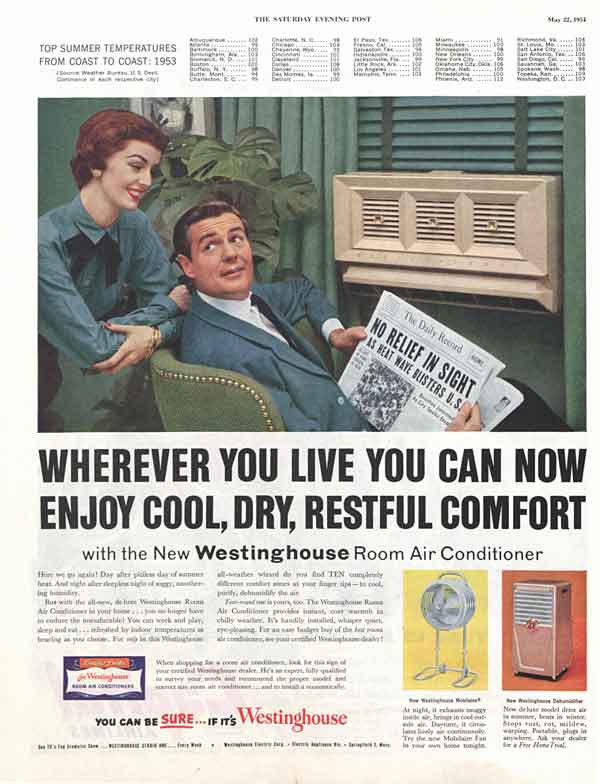The past, present, and future of air conditioning

I’ve done a bit of preliminary research on the topic of the role of air conditioning in American history and culture, and was surprised to discover that there seems to have been so little written about this topic to date.
It seems obvious that the massive population shifts of the second half of the 20th century were very heavily influenced by the development of air conditioning technologies, especially central AC.
Now that it’s starting to get just a little toasty even in the Great White North, this whole topic may be taking on some real urgency. My friend Steve the Meteorologist notes:
Another record high in Lytton, therefore Canada: 49.6 C 121.2 F.
Prior to this heat wave, the Canadian record was 113, set in Yellow Grass*, Saskatchewan in July 1937. In short order:
Sunday June 27, Lytton, BC: 115
Monday June 28, Lytton, BC: 118
Tuesday June 29, Lytton, BC: 121That’ll be it for the records from this heat wave. 107 today, then a stretch of 90s.
*I’m tired of naming things! When is this survey trip going to end!
I looked up some stats on current levels of air conditioning in the US. These are from the U.S. Census’s American Housing Survey, and they’re slightly out of date (2015):
Percentage of US housing units with air conditioning (I believe this includes central, evaporative coolers, wall and window units etc.): 89%.
I was quite surprised it was that high, although I wasn’t surprised that AC of some form or another is close to universal, apparently even in the lowest-income housing, in the Deep South and the Gambling/Snowbird Belt.
Percentage of housing units with AC in major metro areas:
New Orleans: 99.5%
Tampa: 99.3%
Las Vegas: 99.3%
Austin: 99.3%
Kansas City: 99.2%
As far as major metro areas go, we have two massive outliers:
Seattle: 33.7%
San Francisco: 36.3%
The third-least air conditioned major metro area in the country is Portland, but it is (or was six years ago) at 69.9%. The fourth and fifth are LA and Denver, at 72.8% and 79.4% respectively.
When I moved to Colorado 31 years ago it was a point of pride among many Boulderites at least not to have AC. Since there’s no humidity in Colorado and the temperature usually plunges at night even in the middle of the summer, people loved their whole house fans and frantic window opening and closing routines, while sneering at AC as an innovation of degenerate Baby Boomer culture, like hula hoops and pet rocks etc. (Also the median price of a single family house in Boulder was $128,00, which is $250,000 in today’s money. Today that same house costs $1.2 million, but does include a Black Lives Matter sign. Here’s an excellent recommendation to Generations X Y Z inclusive on how to buy a house in this and similar markets).
I understand it’s a big problem in Seattle at least — don’t know about SF in this regard, or Canada for that matter — that much of the housing stock simply wasn’t built with even the possibility of AC in mind, which makes it difficult to retrofit (A similar problem exists all over northern Europe, where even today almost nobody has AC but 90+ degree days are now vastly more common than they were even a couple of decades ago. Another critical social issue is how a lot more AC is going to put a lot more stress on power grids).
Anyway this is a topic that deserves more attention than it has gotten so far from social scientists and other purveyors of Critical Race Theory.


